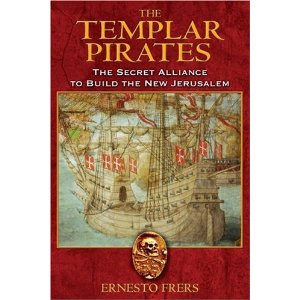
Order The Templar Pirates: The Secret Alliance to Build the New Jerusalem From amazon.com.
By Ernesto Frer
Paperback: 178 pages
Publisher: Destiny Books
Language: English
ISBN: 978-1594771460
 If ever a book resembled a Wikipedia entry, this one is it. Actually that isn’t a fair assessment for two reasons.
If ever a book resembled a Wikipedia entry, this one is it. Actually that isn’t a fair assessment for two reasons.
First, when one sees one subject linked to another on Wikipedia, it does not mean the author is trying to make a connection where one does not exist. However, in The Templar Pirates we jump from the Romans to the Vikings to the Templars and on to the Pirates with the only links between the subjects being the author’s own unsubstantiated theories. I realize that the “alternative historian” trade relies on converting possibility to fact from one chapter to the next, but at least the majority of them are clever about it.
Second, if this were a Wikipedia entry, someone would come along at some point and expunge the inaccuracies in an attempt to “clean up” the article. However, in the Templar Pirates we are left with proof positive that there was no fact checker of technical editor employed on this project.
As such, we learn the following about the Templars:
1 That Bernard of Clairvaux was one of the most fascinating and obscure characters of the Christian hagiography.
Indeed, Bernard of Clairvaux was so obscure that he reformed the Cistercian Order, was instrumental in securing papal support for the Templars, preached the Second Crusade, wrote numerous sermons and was canonized within two decades of his death in 1153.
2. The Templars were sceptical regarding the Third Crusade and steered away from the campaign favoured by Pope Urban III, which aggravated their differences with the Vatican.
In the parlance of the Internet generation, one can only respond to such inaccuracies with the acronym WTF? The Templars were involved throughout the Third Crusade, but their most noted participation was during the Battle of Arsuf in 1191.
But none of this has anything to do with the theme of the book – how the Templars became pirates. After enduring inaccuracy after inaccuracy we learn that:
3. The Templars possessed a large fleet of modern ships and although no one knows how many ships they had ALL SOURCES agree that it was large and powerful.
Well authentic Templar historians like Malcolm Barber and Helen Nicholson disagree although those who have read their work are unlikely to pick up Frer’s book and visa versa.
But perhaps Frer’s greatest ignorance of the history of the Templars lies in his claims about the arrest of Jacques de Molay, which are worthy of quoting in their entirety:
“The Last Grand Master, Jacques de Molay, remained a fugitive for four years until he was caught by the Holy Office, tortured with brutal sadism, and finally burned at the stake.” P. 41
“Some sources hold that De Molay himself embarked [aboard the Templar fleet] that night, and that his capture four years later occurred while he was returning to accomplish a secret mission.” P. 42
De Molay was, of course, arrested on October 13, 1307 and spent the remaining years of his life in prison, until his execution on March 18, 1314.
When the author gets so many fundamental facts about the Templars wrong, it is impossible to take his claims that the Templars became pirates to get back at the Catholic Church with any degree of seriousness. Ironically, the one Templar who actually engaged in piracy, Roger de Flor, is not mentioned in the book.
Order The Templar Pirates: The Secret Alliance to Build the New Jerusalem From amazon.com.
About Us
TemplarHistory.com was started in the fall of 1997 by Stephen Dafoe, a Canadian author who has written several books on the Templars and related subjects.
Read more from our Templar Reviews & Interviews Archives – Templar History
